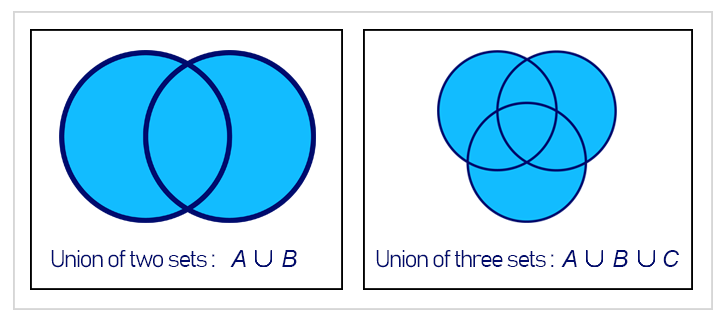Python: Union of sets
Python sets: Exercise-7 with Solution
Write a Python program to create a union of sets.
From Wikipedia,
In set theory, the union (denoted by ∪) of a collection of sets is the set of all elements in the collection. It is one of the fundamental operations through which sets can be combined and related to each other. A nullary union refers to a union of zero (0) sets and it is by definition equal to the empty set.
The union of two sets A and B is the set of elements which are in A, in B, or in both A and B. In symbols,
A ∪ B = {x : x ∈ A or x ∈ B}
For example, if A = {1, 3, 5, 7} and B = {1, 2, 4, 6, 7} then A ∪ B = {1, 2, 3, 4, 5, 6, 7}. A more elaborate example (involving two infinite sets) is:
A = {x is an even integer larger than 1}
B = {x is an odd integer larger than 1}
A ∪ B = {2,3,4,5,6,...}

As another example, the number 9 is not contained in the union of the set of prime numbers {2, 3, 5, 7, 11, ...} and the set of even numbers {2, 4, 6, 8, 10, ...}, because 9 is neither prime nor even.
Sets cannot have duplicate elements, so the union of the sets {1, 2, 3} and {2, 3, 4} is {1, 2, 3, 4}. Multiple occurrences of identical elements have no effect on the cardinality of a set or its contents.
Sample Solution-1:
Using union() function
Python Code:
setc1 = set(["green", "blue"])
setc2 = set(["blue", "yellow"])
print("Original sets:")
print(setc1)
print(setc2)
setc = setc1.union(setc2)
print("\nUnion of above sets:")
print(setc)
setn1 = set([1, 1, 2, 3, 4, 5])
setn2 = set([1, 5, 6, 7, 8, 9])
print("\nOriginal sets:")
print(setn1)
print(setn2)
print("\nUnion of above sets:")
setn = setn1.union(setn2)
print(setn)
Sample Output:
Original sets:
{'blue', 'green'}
{'blue', 'yellow'}
Union of above sets:
{'blue', 'yellow', 'green'}
Original sets:
{1, 2, 3, 4, 5}
{1, 5, 6, 7, 8, 9}
Union of above sets:
{1, 2, 3, 4, 5, 6, 7, 8, 9}
Pictorial Presentation:
Visualize Python code execution:
The following tool visualize what the computer is doing step-by-step as it executes the said program:
Sample Solution-2:
Using | operator
Python Code:
setc1 = set(["green", "blue"])
setc2 = set(["blue", "yellow"])
print("Original sets:")
print(setc1)
print(setc2)
setc = setc1 | setc2
print("\nUnion of above sets:")
print(setc)
setn1 = set([1, 1, 2, 3, 4, 5])
setn2 = set([1, 5, 6, 7, 8, 9])
print("\nOriginal sets:")
print(setn1)
print(setn2)
print("\nUnion of above sets:")
setn = setn1 | setn2
print(setn)
Sample Output:
Original sets:
{'green', 'blue'}
{'blue', 'yellow'}
Union of above sets:
{'green', 'yellow', 'blue'}
Original sets:
{1, 2, 3, 4, 5}
{1, 5, 6, 7, 8, 9}
Union of above sets:
{1, 2, 3, 4, 5, 6, 7, 8, 9}
Visualize Python code execution:
The following tool visualize what the computer is doing step-by-step as it executes the said program:
Sample Solution-3:
Union of more than two sets:
Python Code:
setn1 = set([1, 1, 2, 3, 4, 5])
setn2 = set([1, 5, 6, 7, 8, 9])
setn3 = set([3, 4, 5, 3, 9, 10])
setn4 = set([5, 7, 9, 10, 12, 14])
print("\nOriginal sets:")
print(setn1)
print(setn2)
print(setn3)
print(setn4)
print("\nUnion of first three sets:")
setn = setn1.union(setn2, setn3)
print(setn)
print("\nUnion of above four sets:")
setn = setn1.union(setn2, setn3, setn4)
print(setn)
Sample Output:
Original sets:
{1, 2, 3, 4, 5}
{1, 5, 6, 7, 8, 9}
{3, 4, 5, 9, 10}
{5, 7, 9, 10, 12, 14}
Union of first three sets:
{1, 2, 3, 4, 5, 6, 7, 8, 9, 10}
Union of above four sets:
{1, 2, 3, 4, 5, 6, 7, 8, 9, 10, 12, 14}
Visualize Python code execution:
The following tool visualize what the computer is doing step-by-step as it executes the said program:
Python Code Editor:
Have another way to solve this solution? Contribute your code (and comments) through Disqus.
Previous: Write a Python program to create an intersection of sets.
Next: Write a Python program to create set difference.
What is the difficulty level of this exercise?
Test your Programming skills with w3resource's quiz.
Python: Tips of the Day
Find current directory and file's directory:
To get the full path to the directory a Python file is contained in, write this in that file:
import os dir_path = os.path.dirname(os.path.realpath(__file__))
(Note that the incantation above won't work if you've already used os.chdir() to change your current working directory, since the value of the __file__ constant is relative to the current working directory and is not changed by an os.chdir() call.)
To get the current working directory use
import os cwd = os.getcwd()
Documentation references for the modules, constants and functions used above:
- The os and os.path modules.
- The __file__ constant
- os.path.realpath(path) (returns "the canonical path of the specified filename, eliminating any symbolic links encountered in the path")
- os.path.dirname(path) (returns "the directory name of pathname path")
- os.getcwd() (returns "a string representing the current working directory")
- os.chdir(path) ("change the current working directory to path")
Ref: https://bit.ly/3fy0R6m
- New Content published on w3resource:
- HTML-CSS Practical: Exercises, Practice, Solution
- Java Regular Expression: Exercises, Practice, Solution
- Scala Programming Exercises, Practice, Solution
- Python Itertools exercises
- Python Numpy exercises
- Python GeoPy Package exercises
- Python Pandas exercises
- Python nltk exercises
- Python BeautifulSoup exercises
- Form Template
- Composer - PHP Package Manager
- PHPUnit - PHP Testing
- Laravel - PHP Framework
- Angular - JavaScript Framework
- Vue - JavaScript Framework
- Jest - JavaScript Testing Framework
